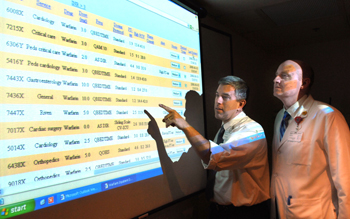
Mark Sullivan, Pharm.D., left, and Dan Johnson, Pharm.D., track warfarin useage in the pharmacy. The new dashboard is designed to decrease adverse drug events. (Photo by Neil Brake)
Monitoring strategy keeps close eye on warfarin dosing
In an effort to reduce the number of adverse drug events (ADE) at Vanderbilt Medical Center, a multidisciplinary team has designed a strategy to monitor the dosing of warfarin, a common anti-clotting drug with a host of potential side effects.
“Dosing of drugs, particularly warfarin, is not straightforward, so we have created a system that leverages IT to monitor patients on high-risk drugs so we can provide reminders and feedback to the physician team in a timely manner,” said Sebastian Strom, M.D., assistant professor of Medicine.
Warfarin is an anticoagulant, designed to interfere with the normal physiologic functions that cause blood to clot and prevent clots from forming. It is typically given to patients with deep vein thrombosis, pulmonary embolism, atrial fibrillation and mechanical heart valves. Almost every medication interacts with the way warfarin is metabolized in the liver. In addition, the dose that people take on a daily basis ranges from 1 milligram to 20 milligrams.
“Each patient can respond differently to the same dose, with one patient not having enough drug response and having a clot in their lungs, brain or in the deep veins of their legs; another patient may have appropriate drug response, and a third patient may have a significant bleeding episode, all at the same dose,” said Mark Sullivan, director of Vanderbilt University Hospital pharmacy operations.
Improving the safety of anticoagulant medications is also one of the Joint Commission National Patient Safety Goals for 2008.
“It is one of our goals to be best in class for medication safety,” said C. Wright Pinson, M.D., M.B.A., associate vice chancellor for Clinical Affairs and chief medical officer. “This is just one of the efforts that looks at the dosing of dangerous drugs. Among the classes of drugs that cause the most side effects, anticoagulation is by far one of the most common ones.”
A multi-disciplinary team has designed a new concept in the form of a pharmacy dashboard intervention that Strom says is “quite unique.” The tool allows the pharmacy to easily identify on a computer screen all inpatients who are on warfarin and quickly assess the need for an intervention based on two key alerts: international normalized ratio (INR) greater than three and rate of increased INR greater than 0.5 over a 24-hour period.
The next screen allows the user to see additional patient data such as interacting medications and labs for trending, both of which are very helpful in assessing the need for a dose change. The physician team receives a call or a text page from the pharmacist when the warfarin dose appears to require modification.
“Since the new intervention was launched four months ago we have seen a 50 percent reduction in the time patients have an INR of 4.0 or greater. Over time, this will translate into fewer bleeding complications for our patients,” Strom said.
Bleeding is the most common side effect of too much warfarin, and the formation of clots due to too little warfarin is the other adverse outcome. Patient education about drug side effects and interactions with other drugs and foods is also vital to the safe use of warfarin.
During fiscal year 2007, there were 10,450 warfarin days and 3,356 total patient encounters with warfarin at Vanderbilt. About one in 10 adult patients at Vanderbilt is on the medication, a sizeable patient population, Strom said.
“Before the pharmacy dashboard was available, data had to be gathered from several different systems, then collated and reviewed. Thanks to cooperation between some key staff in Informatics and Pharmacy we were able to develop a tool that did the data gathering for us,” Sullivan said.
The pharmacy dashboard is accessed via the intranet by the clinical pharmacist assigned to a particular service.
“It is one of a new family of dashboards that coordinates giving real time views of the status of the patient against their individual plan. These views reflect the decisions and work of all of the professionals involved in the care of a patient,” said Bill Stead, M.D., associate vice chancellor for Health Affairs and the architect behind the concept of process control dashboards.
Another pharmacy dashboard — for heparin — is in development and one already exists for certain antibiotics that cause kidney failure.
Other members of the pharmacy dashboard development team are Jack Starmer, M.D., assistant professor of Biomedical Informatics; Russ Waitman, Ph.D., assistant professor of Biomedical Informatics; Josh Peterson, M.D., M.P.H., assistant professor of Medicine and Biomedical Informatics; Ioana Danciu, health system software engineer; Cori Nelsen, pharmacist; Dan Johnson, clinical pharmacist; Erin Bedard, pharmacist; and VUSM student Ira Phillips.













